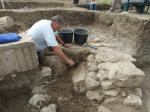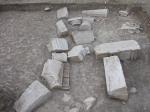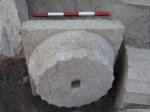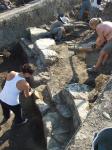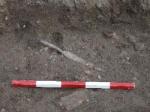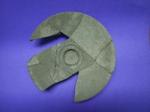Summary (English)
In 2008 and 2009 a triglyph and metope were discovered as spolia in the Second Tower and in a First Squatter Period building, indicating that a temple (most likely) had fallen into ruins somewhere on the acropolis and its stones were reused. This opened the possibility that the propylon might lead into the temple precinct. A narrow trench was excavated more than fifty meters following this alignment (towards Sector 6). Modern churned-up debris from when the site was private farmland, then fairly sterile undisturbed ancient soil with just a few potsherds and roof tile fragments, and a sandy gravel that is the subsoil of the plateau of Bylazora were excavated. This lead to the conclusion that the center of the acropolis was a large open area and that the buildings are going to be found along the fortified periphery of the acropolis. Also a several stones of a building of the Doric order; more than likely from a temple (other possibilities: a stoa, colonnade, ceremonial gate, treasury) were found. The “temple stones” had clearly been cut up and probably prepared for firing into a lime kiln. Beneath the “temple stones” a large foundation was documented. Although the location of the temple is still problematic, there is a possibility that this might be the interior stones of the temple stereobate (leveling course).
Further to the west, in Sector 6, the trenches revealed the western acropolis defensive wall. This segment of the acropolis wall is much more massive than that section uncovered in Sector 3. The extant wall in Sector 6 was more than three meters thick in some parts and it is preserved to a height of almost 3.5 meters. On the last day of the excavation season a small portion of a structure that may be the western gate of the acropolis was partially opened.
The new evidence from the excavations in 2010 updated the established chronology from 2009 by two more periods or phases:
Phase 5: А period of partial abandonment of at least the northern part of the acropolis.
Phase 6: A Second Squatters period from the early 2nd century BC. A nearly 0.5 meter thick layer of sterile soil is laid down over the ruins of the First Squatter Period, and people again living in the ruins of the former public structures of the city. Squatters utilized the still standing lateral walls of the propylon, as well as the magazines in the casemate wall of the acropolis. This is the last phase of the urban habitation of Bylazora.
Director
- William Neidinger - Texas Foundation for Archaeological and Historical Research
Team
- Stefan Danev - Museum of Sveti Nikole
- Eulah Matthews - Texas Foundation for Archaeological and Historical Research
Research Body
- Museum of Sveti Nikole
- Texas Foundation of Archaeological and Historical Research





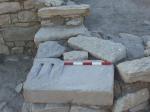
![Download [PDF]](/excavation/skins/fasti/images/results/download_sml.png)
